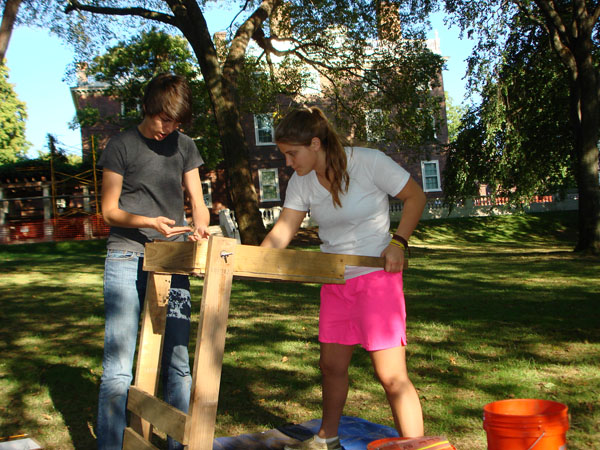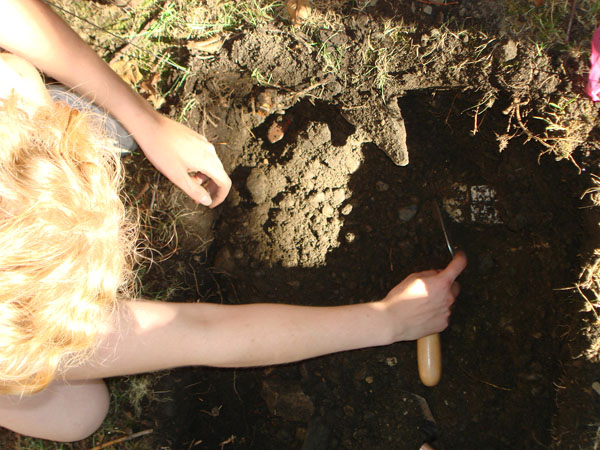Excavation Unit
This photograph is from the 2008 season of a Brown University course titled “The Archaeology of College Hill” in which archaeology undergraduate students learn archaeological methods by participating in a real archaeological excavation in the College Hill area of Providence, Rhode Island. Professors for the course pick locations near the University to do the work. They usually host community archaeology days and invite the public to view the work.
The Practice of Archaeology: What Do Archaeologists Do?
Essay by Rebecca Marisseau, Ph.D. Candidate in the Department of History at Brown University
What do archaeologists do? Archaeologists study past human societies through their material culture. Material culture can consist of anything made, used, or shaped by humans, including things like clothing, jewelry, architecture, eating implements, and even landscapes. By interpreting material culture, archaeologists hope to answer questions about how past societies lived, including: Where did people sleep? What did they wear? How and what did they eat? Did they trade? And so on.

The challenge for archaeologists, especially those who study prehistory, is that much of this evidence (though not all) is underground. Objects might be underground due to human causes (like the construction of a new structure on top of an older site) or environmental causes (like soil accumulation). Archaeologists try to dig these materials from the ground as carefully as possible so as not to damage fragile artifacts and to preserve any information about context, or the way the objects are positioned in the soil. Archaeologists use shovels during their excavation, but when they need to be especially careful, they use tools called trowels (or sometimes even toothbrushes!) to slowly and gently uncover objects. Along the way, the archaeologists take many pictures and very detailed notes to keep track of what was uncovered, where objects came from, and other information (like soil type or evidence of charcoal) that might help them reconstruct the site.
What can archaeologists hope to find when they dig? Archaeologists look for features, which are components of architecture like walls, foundations, and fire pits.1Rhode Island Historical Preservation and Heritage Commission, Native American Archaeology in Rhode Island, (E.A. Johnson Company: 2002), 44. Archaeologists also look for artifacts, although it is rare to find artifacts that are whole. Usually, they find broken or incomplete objects, like sherds of pottery or a stone ax head without its wooden handle. Objects may be fragmented because they have been exposed to the weather or to centuries of farming, construction, and soil erosion, but they also might have been broken before being discarded by a human in what archaeologists call a midden, or trash pit. Archaeologists like to study trash pits because they can tell us a lot about daily life. Think about if someone were to study the daily trash from you or your family. What would they learn? Perhaps about what you like to eat, where your food comes from, or about the dishes and other materials you use every day. For these reasons, archaeologists are interested in the trash of past societies.
Some artifacts survive better than others, depending on what they are made of. Objects that are made out of organic materials (which come from sources that were once living) like plants, wood, and animal bones, decay over time. Inorganic materials, which are made from non-living materials like clay, stone, and metals, tend to survive better because they do not decay. Still, they can be broken or damaged in other ways. Clay pottery, for example, is very fragile, and archaeologists typically find pottery fragments rather than whole pots. Recovered artifacts are usually brought back to a lab space where they are cleaned, preserved, and stored so that archaeologists can continue to study them.2Ibid., 46.
All told, archaeologists are only ever given an incomplete picture of the past, so it is very important for archaeologists to record every detail of an excavation, no matter how small. By studying these details, archaeologists are able to piece together some of the missing links of the material record. For instance, it is challenging for archaeologists of early New England to study early Native American house structures, called wetus, because they were made with wooden posts that have since decayed. However, during an excavation, archaeologists might notice small circular stains in the soil, called postholes. Postholes are created when wooden posts decay in the soil.3Ibid.,43. By mapping postholes on a site, archaeologists can make inferences about how big wetus were and if they stood alone or were part of a larger group. Such information can help the archaeologist learn about things like the size of family groups and communities. Overall, an archaeological site is like a jigsaw puzzle, and with careful attention, archaeologists can put together the pieces to reconstruct past societies.4Ibid., 44.
Terms:
Prehistory: the period of time before written records in a given culture or society
Artifact: an object made or shaped by a human
Features: components of architecture, such as walls, storage pits, foundations, and fire pits
Sherd: a fragment of pottery
Midden: a trash pit
Organic materials: materials made from things that were once living. Examples include wood or animal bones. These materials decay over time.
Inorganic materials: materials made from non-living sources, like stones, metals, or clay. These materials do not decay but can be broken or damaged in other ways.
Posthole: a small, organic stain in the soil that was created by a decayed wooden post
Inference: a conclusion drawn from close examination of the evidence, or an educated guess
Questions:
What is material culture? Why do archaeologists study material culture?
Why do archaeologists tend to find broken or incomplete artifacts during an excavation? Why do you think an archaeologist might find a stone arrow point, but not its wooden shaft? How can these partial objects still be useful to the archaeologist?
Why is it important for an archaeologist to record every detail of an excavation and to collect every artifact?
- 1Rhode Island Historical Preservation and Heritage Commission, Native American Archaeology in Rhode Island, (E.A. Johnson Company: 2002), 44.
- 2Ibid., 46.
- 3Ibid.,43.
- 4Ibid., 44.

